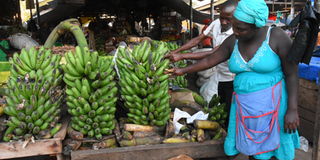Inflation pushes prices of commodities higher

Food vendors in Nateete, Kampala go about their business. The price of goods and services have increased because of inflation over the last 12 months. PHOTO | MICHAEL KAKUMIRIZI
The price of goods and services in Uganda as measured by the Uganda Bureau of Statistics (Ubos) annual headline inflation increased to 10.7 percent over the last 12 months.
The annual headline inflation was previously at 10 percent.
This was driven by an increase in the prices of maize flour, rice and sugar, among others.
Headline inflation is the measure of prices of all items in the consumer price index of goods and services
While presenting the Consumer Price Index yesterday at Statistics House, the Principal Statistician of prices statistics, Mr Edgar M. Niyimpa, said the core inflation, which excludes volatile items such as food, energy (fuel), and water from the Consumer Price Index, increased to 8.9 percent in the year ending October, compared to 8.1 percent registered in the year ended September due to other goods inflation that increased to 11.2 percent in the year ending September, up from 10.2 percent recorded in August.
Mr Niyimpa said maize flour in particular inflation increased to 91.5 percent in October compared to 60.2 percent in September and rice inflation increased to 43.3 percent in October compared to 32.2 percent in September.
These items filtered in both headline and core inflation levels of Uganda in the year ending October 2022.
Detailed retail prices for selected commodities indicate that during the period, 1kg of maize flour increased from Shs2,046 in October 2021 to Shs3,967 in October 2022, while the price for 1kg of rice increased from Shs3,610 to Shs5,172.
“In addition, the increase in Annual Food Crops and Related Items inflation was mainly due to Annual ‘vegetables, tubers, plantains, cooking bananas and pulses’ inflation that increased to 33.8 percent for the 12 months to October 2022, compared to 30.3 percent registered in September,” Mr Niyimpa said.
He added that matooke (bunch) inflation increased to 75.4 percent in October compared to 59.8 percent in September.
During the period, a cluster of matooke increased from Shs754 to an average price of Shs1,233 in October. One kilogram of sugar rose from Shs3,073 to Shs5,181 in October.
One kilogramme of brown irish potatoes rose from Shs1,234 to Shs1,963, 1kg of fresh cassava increased from Shs706 to average price of Shs1,048 in October.
A kilo of watermelon rose from Shs1,066 to Shs1,236, while passion fruits rose from Shs5,153 to Shs5,704 in October.
One kilogramme of mukene (silver fish) increased from Shs12,277 to Shs16,584, in October.
However, Mr Niyimpa said the annual Energy Fuel and Utilities (EFU) inflation registered at 15.2 percent in the year ending October 2022, compared to 18.7 percent in the year ending September.
This was mainly due to annual Liquid Energy Fuels Inflation that registered 42.1 percent in the year ending October 2022 compared to 50.6 percent in the year ended September 2022.
Specifically, annual petrol inflation registered 45.6 percent in October 2022, compared to 55.3 percent in September 2022. In addition, diesel inflation registered 52.1 percent in October 2022, compared to 63.0 percent registered in September.
A litre of petrol increased from Shs4,214 in October 2021 to Shs6,153, diesel (one litre) increased from Shs3,778 to Shs5,769, while paraffin has risen from Shs3,097 to Shs4,544 in October.
During the period under the review, the Ubos analysis by geographical areas and income groups revealed that Arua registered the highest inflation of 13.4 percent for the 12 months to October 2022 compared to 14.4 percent recorded in September 2022. This was mainly driven by annual ‘Food and Non-Alcoholic Beverages’ inflation that increased to 23.1 percent in October 2022 compared to 24.3 percent registered in September 2022.
The second highest inflation was registered in Mbale at 13.3 percent for the 12 months to October 2022 up from 12.5 percent recorded in September 2022. This was also mainly driven by annual ‘Food and Non-Alcoholic Beverages’ inflation that increased to 27.3 percent in October 2022 compared to 25.2 percent registered in September 2022.
The least annual Inflation was registered in Kampala High Income at 9.1 percent for the 12 months to October 2022 compared to 8.3 percent recorded in September 2022.
This was mainly due to the annual insurance and Financial Services Inflation that registered minus 0.1 percent in October the same rate registered in September.
World bank reacts
The World Bank in its latest Commodity Markets Outlook report of October 26 said the shrinking value of the currencies of most developing economies is driving up food and fuel prices in ways that could deepen the food and energy crises that many of them already face.
“Although many commodity prices have retreated from their peaks, they are still high compared to their average level over the past five years,” said Dr Pablo Saavedra, the World Bank’s Vice President for Equitable Growth, Finance, and Institutions. “A further spike in world food prices could prolong the challenges of food insecurity across developing countries.”




